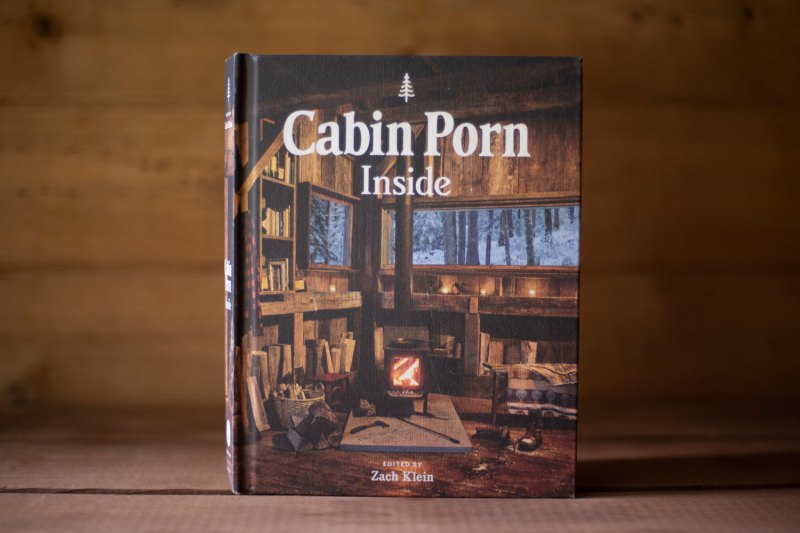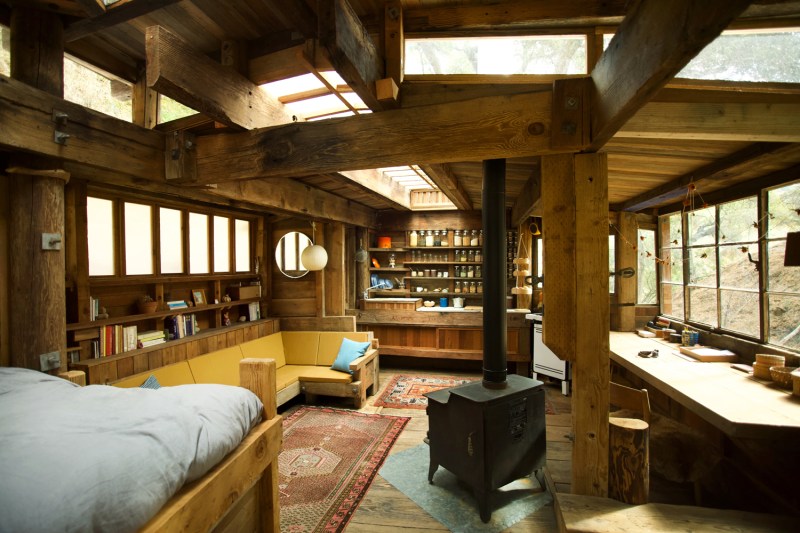
Ten years ago, Vimeo and DIY co-founder Zach Klein was wasting time the way any desk-bound digital laborer might do: collecting a digital scrapbook of images that represented the life he aspired to. But unlike the majority of vision boards with their high-rise apartments poised on cosmopolitan beaches, Zach’s collection featured tiny, hand-built dwellings nestled amid towering conifers and craggy boulders. Little did he know that by hitting “publish” on his social media feed, he would inspire a worldwide lust for cozy retreats from the modern world.
Klein’s passion for cabins has become a worldwide phenomenon, thanks to his decision to make his curated image collection available online. The Tumblr site Cabin Porn had over 10 million unique visitors and 350,000 followers, spawning a slew of copycat feeds that represent a significant slice of the social media landscape. More importantly, Cabin Porn has redefined #lifegoals for untold numbers of people, who traded out the penthouse dreams for Zach’s vision of a personal shelter in a quiet place.
On October 1, Cabin Porn will also release a follow-up to its bestselling book. The new volume, Cabin Porn: Inside, reveals what Cabin Porn fans ask for most: an invitation inside the cabin of their dreams. Along with gorgeous imagery of cabins from all around the world (Norway, New Zealand, Kentucky, Spain, Indonesia, Vermont, and more), Cabin Porn: Inside features ingenious design ideas and inspiring stories of a simpler life.

We got the chance to talk with Zach Klein about what led to this book, as well as his thoughts on the impact of cabins and his Cabin Porn project 10 years on.
The Manual: What was your first important experience with a cabin? What do you remember about it?
Zach Klein: My first experience that really took me to this place was, I was invited to a friend’s “family camp,” as they call it in New England. It was a big stretch of land in the 1000 Islands region of New York that had been built by this fellow’s parents. He’d spent his childhood summers there, and it was filled with yurts, outdoor kitchens, a wooden tub fed by the brook. Every summer, all the extended family and friends would come together for a couple of weeks to camp and perform maintenance on all the buildings.
For me, this was the culmination of a lifetime of wanting to get closer to a lifestyle that let me live outside. I was just so enchanted with this family — two generations that had completely oriented their lives to being outside together and building friendships around the place. So much so that everyone whom this land had touched felt a calling to return every year to help maintain it. I found it so powerful to create family, to develop relationships, to have this touchstone in your life where you can host people, collaboratively build and maintain together, a place that becomes a recurring scene in all these major moments in your life. As someone who moved around a lot as a kid, it occurred to me that no matter what my lifestyle might become, I needed to have a place in my life that was a constant.
TM: How did Cabin Porn: Inside come about? Did you always intend to do a second book focusing on interiors?
ZK: I never had intentions to do a first book! Honestly, the Cabin Porn thing has been an extraordinary surprise for me. This idea of really simple homes really captured people’s attention, so I started putting more time into being methodical about what I published. Then we had the opportunity to make a book and the book exceeded all expectations.
When you have a kid, immediately after you can’t imagine having another right away. Then months and years go by, and one day you’re ready. Same with a book — after a few years passed, I decided I wanted to try continuing the series. It occurred to me that virtually every single time we posted something on one of our social media accounts, you could always depend on a comment that said, “What does it look like inside?”

Personally, building my own cabin, I never considered sharing the inside — I considered the inside to be such a vulnerable, personal thing. But people asked for them, and we started going back to our archives and taking a look at what interiors had been submitted to us. We had somewhere between 15,000-20,000 images submitted, and we’ve only published 3,000. We took a look at what we had, solicited interiors of cabins we’re really fond of, and we were able to put together a collection.
TM: What does spending time in a cabin do for people? To that point, what are some of the important elements of a good cabin interior?
ZK: Lots of things. For one thing, I don’t have cell reception at our place, and when people visit, they can’t stop reaching for their pockets to instinctively look at their phone. It takes a few days, but you can work that compulsion out. That is just special because a lot of us aren’t familiar with what that’s like anymore: an office or family where people aren’t constantly distracted by a compulsion to check their device. It’s remarkable when you regain full control of your attention. The quality of time you can spend with people, and with yourself, improves.
It’s remarkable when you regain full control of your attention. The quality of time you can spend with people, and with yourself, improves.
I also find the kind of physical hunger that I work up outside is so satisfying. Having a place in the woods or someplace remote inevitably invites so much maintenance. Half my time at my place is just spent maintaining stuff, and it’s not burdensome. It’s a joy to have such a direct relationship with the land and the buildings we’ve put on it. Doing that brings me to a point of exhaustion that is so satisfying, and that leads to an elevation of meals. Cooking and repairing yourself becomes so important to the process of being there every day, that the food is inherently more satisfying. It also invites opportunities to spend time with people over meals.

Finally, there’s just being outside. Someone asked me about the difference between a cabin and a home. Homes are meant in virtually every way to make the outdoors vague, but I think of cabins as shelters that allow us to be outdoors. You grow a lot more comfortable with weather of any kind, with all different times of day. Your relationship with the outside becomes deeper.
TM: Are there any common visual threads amongst the many cabins you’ve seen and curated?
ZK: There are several ways to answer that. I find what really excites most of our readers are the sort of the elements that have to do with escapism. Those cozy nooks where you’re cuddling up in a bed or a single chair by a fireplace. That place you can imagine sitting down, sinking into, and wasting away a weekend. When we’re posting interiors, we do tend to look for beautifully framed landscapes within a window, hearths and fireplaces, cozy bedrooms that are really modest proportions.

Maybe because I have a just little bit more experience than the average Cabin Porn fan being outside in these places, I’ve come to prioritize pragmatic elements of cabins. I like looking for space where people have clearly lived in it, and clearly customized it since they moved in. It’s the pegs someone tacked into the kitchen wall because that’s where they want to hang their favorite mug. I like looking at all those maker marks that come to be because someone has lived in it day in and day out. That’s what I find so special about cabins. Homes are a little more precious for people — they don’t change very often, and when they do, it’s usually large-scale renovations. But what I love about cabins is that they’re just not precious. The moment you have a whim or need to modify or adapt, you can do that quickly without threatening it or it being expensive or damaging.
I find what really excites most of our readers are the sort of the elements that have to do with escapism. Those cozy nooks where you’re cuddling up in a bed or a single chair by a fireplace. That place you can imagine sitting down, sinking into, and wasting away a weekend.
I’m of the philosophy that when you build a house, you should only build the first 80%, and leave the remaining 20% to design and build over your lifetime. Because from the outset, you can try as hard as you might to imagine how the space will be used, but if you overdesign, you’re limiting the potential for implementing insights that you’ll gain once you start living in the space.
TM: Back in 2015, The New York Times reported that the first get-together at your own cabin property was advertised as a weekend of “bonfires, contemplation, and wood chopping.” Can you explain the appeal of those things for the modern millennial/post-millennial person?
ZK: That was a throw-off line from an email to friends. I was being slightly pretentious and poetic because I was so excited. But what it represented is similar to what I just described (about being outdoors). The city is very exciting and fun, and does totally tap an important part of who we are … the part that wants to socialize and be ambitious. I live in the city too, so I need both things. I think that the one thing living in the city does is depreciate our experience of being human. It’s not very physical. The physical and sensational part of being a person is diminished in the city. Going outside and feeling your muscles ache, smelling wood smoke, feeling the drizzle and the cold wind, seeing the full moon activates me in a very physical way.
Society is novel and interesting, but it is, in a way, a denial of human nature. Every generation has had its brand of retreat into the woods — it’s not a new thing.
I don’t think it’s novel to the millennial age. An article in The New Yorker said that Thoreau’s Walden was the original Cabin Porn, with its depiction of a false reality in the woods. But I think Thoreau’s literature was poignant for the same reason. Society is novel and interesting, but it is, in a way, a denial of human nature. Every generation has had its brand of retreat into the woods — it’s not a new thing.

I think why this idea of a cabin as a gateway to the outdoor experience is so important in our generation is because it’s becoming really difficult for people in our generation to own a home in a place where they want to be. The housing stock doesn’t appeal to us, and it’s way too expensive. In Cabin Porn, you see a simplified reality where you can own a home in a place that is surreal, sublime, naturally beautiful, and the home is modestly sized. It’s a counterpoint to what luxury has been for decades — maybe all we need, maybe all we want, is a very small quiet place somewhere.
TM: As the founder of Vimeo, have you ever thought about a Cabin Porn online series?
ZK: I’ve thought about it, but I don’t know what it is exactly yet. There are already cabin shows, extraordinary home shows, tiny home shows … I don’t want to do anything like that. I’m still trying to figure out what my version of what a Cabin Porn series is, and if it has an audience that would appeal to a studio. If I do something like that, it’s going to be more quiet, simple, and really respectful of the environment.


